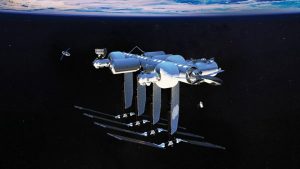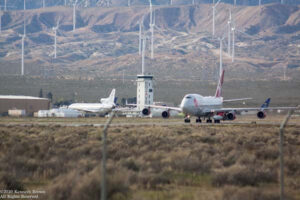Exploring the Japanese Space Programme in 2024 and Beyond
19th Jan 2024
The Japan Aerospace Exploration Agency (JAXA) is a modern rebranding of the Japanese Space Programme in many ways. While the country’s space programmes have their roots in the 20th Century, JAXA only formed in 2003, the result of a merger of other Japanese organisations that were previously responsible for different aspects of space and defence.
What’s the Japanese space programme?
The three organisations merged were Japan’s Institute of Space and Astronautical Science (ISAS), the National Aerospace Laboratory of Japan (NAL), and the National Space Development Agency of Japan (NASDA). Prior to this, it was ISAS that carried out most of the space and planetary research.
JAXA was the result of the merger, administered by the Japanese Ministry of Education, Culture, Sports, Science and Technology (MEXT) and the Ministry of Internal Affairs and Communications (MIC).
We’re entering one of the most exciting periods for space exploration, and some of the countries that some may not have previously associated with being right at the cutting edge are proving themselves to be exactly that. Japan’s long association with technology means there is very little surprise to see them innovating with some of the more interesting rovers and projects we see today.
Below, we explore the Japanese Space Programme, some of the exciting JAXA launches and upcoming projects due to launch in 2024 and beyond. With SLIM making its descent as this is being published, let’s see what’s going up next!
DESTINY+
DESTINY+ is one of the upcoming flagship launches from JAXA. It gets its name from the “Demonstration and Experiment of Space Technology for INterplanetary voYage” and has the remit of a flyby of the Geminids meteor shower and their parent body 3200 Phaethon. The craft will demonstrate JAXA’s capabilities to explore deep space and will also sample dust from the meteors. It’s going to be a very crucial part of the Japanese Space Programme.
The craft will be launched by the tried-and-tested Epsilon S launch vehicle and will spend around 1.5 years raising its orbit from a low Earth orbit to interplanetary when it will fly by multiple near-Earth objects to study them, eventually reaching the 3200 Phaethon in 2029. If needed, the ion engines will be able to perform another orbit to study additional objects.
DESTINY+ will gather data using three scientific instruments:
- DESTINY Dust Analyzer (DDA) — The DESTINY Dust Analyzer (2.7 kg) will be provided by the German Aerospace Center (DLR), and the University of Stuttgart.
- Telescopic Camera for Phaethon (TCAP) — The telescopic camera will be able to take images of the samples.
- Multiband Camera for Phaethon (MCAP) — A multiband camera with a mass of 3.5 kg which will detect light in 390 nm, 550 nm, 700 nm, 850 nm wavelengths.
The spacecraft’s propulsion systems is one of the more interesting elements, with four μ10 solar electric ion engines working together. Its predecessors only used three engines together, on the Hayabusa and Hayabusa2 missions. The engines will achieve thrust of 40 mN.
Originally slated for a 2024 launch, it is more likely to take place in 2025.
MMX
The Martian Moons eXploration (MMX) mission may launch in 2024, with the idea of returning samples from Phobos, the largest moon of Mars. JAXA announced the mission back in 2015 and it will be multi-purpose, and as well as gaining these samples, it will perform flyby observations of Deimos and even track and analyse the climate on Mars.
MMX is setting out to determine whether the Martian moons are actually captured asteroids or they are the result of a collision on Mars itself. JAXA officially approved the development of the project back in 2020 and its progress has been relatively fast since.
The mission could provide us with some stunning imagery along the way. JAXA has partnered with the Japan Broadcasting Corporation to develop something they’re calling the “Super Hi-Vision Camera” that combines a 4K and 8K camera. 8K images of Mars and its moons will regularly be transmitted to Earth as part of the mission.
MMX will carry numerous scientific instruments as part of the payload.
- TENGOO – A narrow field camera for terrain study.
- OROCHI – A wide field visible light camera.
- LIDAR – Light Detection and Ranging, which will use a laser to reflect light from the moon’s surface, and in the process study altitude and albedo.
- MMX InfraRed Spectrometer, a near-infrared observation device to analyse the minerals of the moons of Mars.
- MEGANE – This is a gamma-ray and neutron spectrometer developed in partnership with NASA.
- CMDM – Circum-Martian Dust Monitor, this will analyse dust on the martian moons.
- MSA – Mass Spectrum Analyzer, an instrument to study the ion environment.
MMX could launch in 2024.
HTV-X
The HTV-X is an uncrewed expendable cargo spacecraft and the successor to the H-II Transfer Vehicle. The craft will set out on its first missions to resupply the ISS in the next year.
JAXA’s goal is to become a reliable international partner for space development, and the HTV-X is a huge part of that.
The original proposal for HTV-X and its goals was as follows:
- To re-use the design of HTV’s Pressurised Logistics Carrier (PLC) as much as possible, except for adding a side hatch for late cargo access after the spacecraft-launch vehicle integration.
- To replace the Unpressurised Logistics Carrier (ULC), Avionics Module, and Propulsion Module with a new Service Module.
- To load the unpressurised cargo on top of the Service Module rather than inside the spacecraft.
The first flight, pencilled in for January 2024, is entitled HTV-X1, with the goal of demonstrating the capabilities as well as resupplying the ISS and its cargo.
It will also equip the ISS with some new technology, and deliver further payloads into space:
- i-SEEP (IVA-replaceable Small Exposed Experiment Platform)
- Technology demonstration of lightweight expandable flat antenna
- Mt.FUJI, a technology demonstration for satellite laser ranging
- Microsatellites to be deployed from HTV-X1 after departure from ISS
Nano-JASMINE
Slated for launch in the coming years, the Nano-Japan Astrometry Satellite Mission for Infrared Exploration (Nano-JASMINE) is an astrometric microsatellite that will measure the movement of stars and celestial bodies. It has been developed by the National Astronomical Observatory of Japan, with the help of the University of Tokyo’s Intelligent Space Systems Laboratory (ISSL).
The launch has been continually delayed and was originally supposed to launch together with CHEOPS (Characterising Exoplanets Satellite) in 2019, but was not a part of this launch.
Nano-JASMINE will be Japan’s first isometric survey craft, and only the third in the history of the world. Most recently was Gaia, launched by the ESA back in 2013. The plan is for there to be multiple crafts in the same vein over the coming years.
The spacecraft should boast astrometric accuracy (2–3 mas (milli-arcsecond) for stars brighter than 7.5 magnitude) Nano-JASMINE will be able to detect approximately four times the number of stars as Hipparcos (the HIgh Precision PARallax COllecting Satellite operating in the 1980s and 1990s). Given the time difference between these missions, combining the data sets of Nano-JASMINE and Hipparcos should provide clarity on the motion of stars and celestial bodies since they were originally measured and mapped.
Nano-JASMINE itself is a satellite that is incredibly small with a 35 kg weight overall. It will carry a Ritchey–Chrétien telescope that will make observations in the infrared spectrum, and this will allow for easier observation toward the centre of the Milky Way.
Gallium arsenide (GaAs) solar cells will collect approximately 20 watts of power, and due to limitations with its bandwidth, Nano-JASMINE will make use of onboard raw image processing, but will extract and transmit data when requested.
Nano-JASMINE will then be succeeded by a larger spacecraft, JASMINE (formerly “Small-JASMINE”), that should be launching in 2028.
LiteBIRD
LiteBIRD (Lite (Light) satellite for the studies of B-mode polarization and Inflation from cosmic background Radiation Detection) is a small space observatory system, with the goal of measuring the footprint of the primordial gravitational wave in method of polarisation pattern called B-mode.
LiteBIRD was selected for launch in 2019 by the Japanese space agency and will launch in 2028, with a three year study carried out by observing the Sun-Earth Lagrangian point L2.
LiteBird delves into theoretical science, and may test the theories of cosmological inflation and the Big Bang Theory. It is generally understood that the universe unwerwent rapid expansion after it was formed. The primordial gravitational waves are imprinted in the CMB polarisation map as these B-mode patterns mentioned above. Observing these waves could be a way to understand more on quantum gravity and superstring theory.
Due to the need to separate CMB from the galactic wave emissions, the measurements will cover 40 GHz to 400 GHz and carry out a full 36-month sky survey with two onboard telescopes. A Low Frequency Telescope (LFT) covers 40 GHz to 235 GHz, and a High Frequency Telescope (HFT) covers 280 GHz to 400 GHz. LFT has a 400 mm aperture Crossed-Dragone telescope, and HFT has a 200 mm aperture on-axis refractor and two silicon lenses.
DECIGO (DECi-hertz Interferometer Gravitational wave Observatory)
One project that could be coming further along the pipeline is the DECi-hertz Interferometer Gravitational wave Observatory, a proposal for a gravitational wave observatory. The project has been discussed as early as 2000, and the first naming as “DECIGO” was in a presentation given by Naoki Seto, Kawamura, and Takashi Nakamura back in 2001 in a meeting of the Physical Society of Japan at Okinawa International University.
The observatory is designed to be very sensitive in the low frequency band between 0.1 and 10 Hz, helping to better detect gravity waves in the gap between the sensitivity bands of LIGO and LISA
In a 2021 update JAXA described the DECIGO as part of “four clusters of observatories” placed in heliocentric orbits.
The launch could take place in the 2030s.
Ispace Inc. (Private Japanese Launches)
Alongside JAXA’s missions, ispace Inc. sets out to develop robotic spacecraft and compete for exploration contracts in the private space industry as well as working with space agencies around the world. Their mission is described as enabling clients to “discover, map, and use natural lunar resources.”
The first ispace mission in 2022 was unsuccessful, but Mission 2 is taking place in 2024.
According to a press release it “will serve as the company’s second technological demonstration, based on lessons learned from Mission 1, with the objective of further validating the lander’s design and technology, as well as ispace’s business model to provide reliable lunar transportation and data services.”
“During Mission 2, ispace will conduct initial resource exploration activities, primarily with its micro rover, which is being designed, manufactured, and assembled by engineers in its ispace EUROPE office. The exploration activities will be an important advancement in achieving ispace’s goal and vision of establishing the cislunar economy.”
Mission 2 could be the first private launch to reach the moon, carrying multiple payloads.
- Water electrolyzer equipment from Takasago Thermal Engineering Co., a HAKUTO-R corporate partner
- A self-contained module for food production experiments from Euglena Co.
- Deep space radiation probe developed by the Department of Space Science and Engineering, National Central University, Taiwan
- A commemorative alloy plate modelled after the “Charter of the Universal Century”
- A micro rover developed by ispace Europe
A Bright Future For the Land of the Rising Sun
The Japanese Space Programme has a huge number of other projects that are in progress, with collaborations with NASA and the ESA, such as Comet Interceptor, a robotic spacecraft mission that is being planned by the European Space Agency (ESA) and could launch this decade.
Japan boasts some of the most forward-thinking brains in the modern space industry and a promising private industry and space agency scene. The next decade is certainly one to watch closely from the Land of the Rising Sun.






Thank you for your comment! It will be visible on the site after moderation.